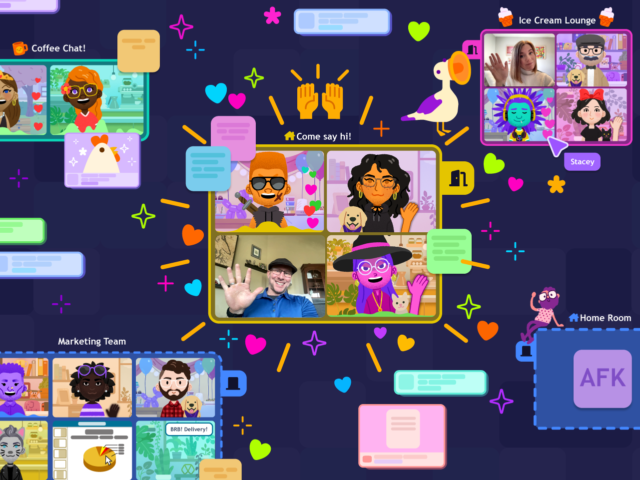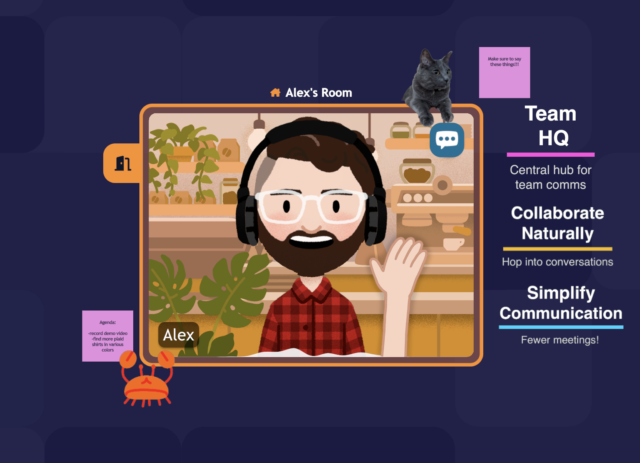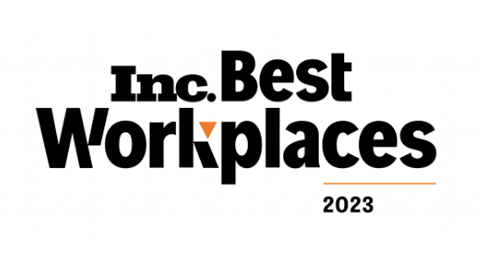I’m making a lot of assumptions in these blogs that anyone here is either very Team Remote-Work, or Team Curious-About-Remote-Work. However, I want to be absolutely clear that my whole premise is that most companies haven’t done authentic remote work yet. What they HAVE done is worked from their homes during a pandemic. Potentially, they have experienced working separately from an in-person, or co-located, team. But remote work is an entirely new paradigm that requires its own unique structure and philosophy.
So it’s worth it to step back a bit and identify the problem space we need to solve, and maybe even take a look at how we got here.
The Before Times
Working outside of the office obviously isn’t new. Folks have been doing it forever. But it bears remembering that remote work was originally designed for an exceptional person, team, or situation. As a result, the intention was to have that exception integrate with a co-located team in a way that inconvenienced that office-based team as little as possible. You might remember familiar experiences such as:
- The contractor or contract team that works remotely on a siloed project and reports back deliverables on a pre-defined cadence
- A traveling employee, like regional sales or product evangelist roles, whose job it was to travel around and visit OTHER co-located teams before reporting back to their OWN co-located team
- Someone happens to be out-of-pocket for the day, but is answering emails or popping into meetings
In all of these cases, the intent was the seamless integration with a co-located team. The focus was never on the remote person or team and what would work best for their specific circumstances.
And it was under these circumstances that we got hit with the pandemic. We had an urgent need to find something that worked and so we worked with what we had a bunch of tools that were made with the explicit purpose of fostering interaction with an old fashioned, co-located team. Part and parcel with this, is we carried over our existing mythologies of how work gets done. But let’s look at that a bit more closely.

Productivity Mythologies
Our original productivity ideas and structures came at a time when work could NOT be done from just anywhere. Truly, the ubiquity and prevalence of the internet has revolutionized work. Yet, we’ve not recalibrated our expectations and understanding of work to go along with it.
Around the end of World War 1, a 9-5 job was a heckin STEAL. There were several movements in the United States to legislate shorter and shorter weekly hours, but we landed at around 40 hours a week by social consensus in the 1940s and that average lasted through the 1990s. But we’re creeping back up on those industrial revolution hours again with tech workers commonly clocking in 60 hours or more a week.
But those extra hours don’t necessarily translate to more work getting done. Rather, we adopted a trend of performative productivity. We were at the office more, but more of our day was taken up by meetings (often including the meta of SCHEDULING meetings), socializing, office politicking and the optics of work. We’ve conflated butts-in-seats time with potential productivity, and this is rife with its own obstacles. A lot of these myths have been dismantled over the past couple years, but we haven’t replaced the habits, expectations and practices. And while there is absolutely a place for in-person collaboration, and there always should be nothing quite hits like a team gathered around in a single space, especially for kicking off projects or high level ideation we vastly overestimate how often this is necessary, and in what use-cases co-location is best served.
With so many folks in one co-located space performing the optics of productivity, one of the biggest issues is the onslaught of distractions. Between endless meetings, noisy workmates, fire drills, lunch planning, fly-by interactions it could be an absolute nightmare to find time to actually get work done. Office Managers, Productivity Experts, and Studio Operations folk became experts at minimizing distractions. Systems like Agile and Waterfall took off to try and organize vast amounts of work through structured and limited meetings, and physical office planning moved toward giant dev pits for collaboration. When that failed, with people turning to headphones as a replacement for their lost office doors, building plans then started backing away from the open office space idea in favor of smaller pods to reduce distractions. And it was absolute anathema to place a break room anywhere CLOSE to where work needed to get done. The intention of all of these improvements and shifts were in the effort to minimize distractions. And I say minimize specifically, because they can never be eliminated. And truly, you wouldn’t want to! But this isn’t a problem with remote work.

Remote Realities
So here is where we are now with remote work. We don’t have nearly the distractions we used to when we worked in co-located spaces. However, because of the weight of all that history and habits, we often still conceive of work within that same framework. This gets harmful when these paradigms work in tandem with remote work. “Work from anywhere” easily becomes “work everywhere” when performative work expectations can be conducted anywhere you have your phone. So it becomes of utmost importance to be aware of and intentional about your time. When we work remotely, we often consider ourselves to be always available when really, we shouldn’t be. We should only be available when we are working. And we should be very specific about when that is, and, more importantly, when that ISN’T. In remote work time paradigms intentionality becomes crucial in a way we didn’t have to think about before.
While it is easy to lose some cultural interactions in the move to remote work, like social rituals and distractions, team culture, the sense-experience of being on a team, or a clear end-point to the day, what we don’t lose is productivity. Rather, using the paradigms and framework of a co-located office and without the distractions and the clear delineation between work and non-work, we run the risk of OVER producing. When you consider yourself always available, and you never gate your time, work can easily lead to burnout much more quickly than if we were still in the land of social distractions.
All this provides us an opportunity to give the structure and framework of work a redesign from the ground up to be more sustainable, and leaning into the strengths of remote work while accommodating for its difficulties.

How to Build from the Ground up
There’s a lot of ground to cover here, and a lot of issues to address, noodle on, and experiment with! Here are some thoughts to get you started.
Culture
This is a big, meaty one. With the sense-experience of the team being one of the most noticeable parts of work that we’re struggling with in remote structures, there is a lot of fertile ground here to find something that works for your team. This includes things like:
- Social rituals – Being intentional and cognizant of ways your team can interact and bond. Be sure to give space to and facilitate the non-work parts of work humans are more than just the parts of themselves that produce work product.
- Onboarding – Oooo I talk about this a LOT over in this blog, but think about the very first moments a new employee joins and what goals and expectations you are setting for them at the outset.
- Tools – What tools are you using to hold your team and facilitate collaboration? Were they designed with a co-located-first approach in mind? Or are they made specifically for folks working remotely? Our team makes a virtual HQ culture and collaboration app, Tangle, and that’s our contribution to the conversation. But check out other tools that were designed with an assumption of dispersed teams, like Figma and Discord, and see the difference when the initial design paradigms are built for teams like yours.
Policies and Processes
A lot of times, you DO need structure to give people permission or set expectations on what work should look like at your company. Here are some things you can consider:
- Core hours/work hours – Be very intentional about your hours of operations, and set those expectations with your team. If your team works across time zones, you may have core hours that are different from work hours, or you may not have core hours at all! You may also want to experiment with 4-day work weeks, or reduced weekly hours. One of the strengths of remote work is giving control of an individual’s work day back to them, but it’s important to be clear about expectations and boundaries to make sure that we dismantle these old philosophies about more hours = more committed employee.
- PTO and Holidays – When vacations and holidays can occur at the same kitchen table where you work, it can be difficult to unwind. Think about ways you can make sure to protect employees from work bleeding into their PTO, either with rituals or with using tools to shut off work. Encourage folks to uninstall Slack from their phone while they are out it will be there when they get back. Maybe kickoff holidays and studio closures with a little social time for the final hours of the prior working day.
- Benefits – Benefits of being co-located will inherently be different. You’re not going to need an arcade in the break room, but you might still want to figure out a way to get snacks to everyone. Is everyone working really hard or you’re working toward a milestone? Maybe find ways to help out with their boring household tasks like cleaning or grocery shopping. Have generous home office reimbursals, think about electricity and internet stipends, and maybe offer pet boarding or dog walking services. Go even further, get weird with it. You can find almost anything on the internet.
Remote work is a space where we can really play. Since work-from-anywhere is an entirely new paradigm, I invite you to talk to your team, find their pain points, and experiment with creative ways to solve them. Think of this as a growing, evolving process and get excited about crafting a sustainable, mindful workplace that allows employees to reclaim their time and structure their lives in a way that is comfortable for them. And lastly, please, pretty please find places to share your findings! It can be strange to admit that your team is going against the grain, but if you’ve found solutions that really resonate with your team, sharing your findings with the industry allows us to find and develop new frameworks for this remote-work paradigm.
Thanks for hanging out with me while I chat about culture again! To learn more about Tangle or sign up for Early Access, head over to our website.



